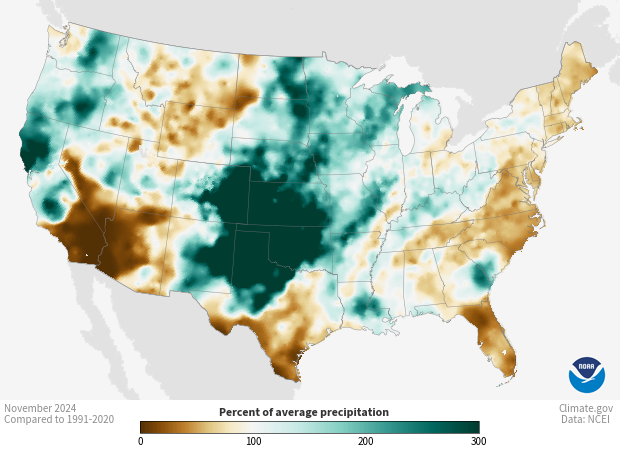Data Snapshots Image Gallery
Precipitation - Monthly Percent of Average
- Dataset Details
- Monthly images from 2000 to present
- Download Directories
- Click on any of the links below to view a directory listing of images and assets related to this dataset.
Colors show where and by how much monthly precipitation totals differed from average precipitation for the same month from 1991-2020. Green areas were wetter than the 30-year average for the month and brown areas were drier. White and very light areas had monthly precipitation totals close to the long-term average.
Daily measurements of rain and snow come from weather stations in the Global Historical Climatology Network (GHCN-D). Volunteer observers or automated instruments gather the data and submit them to the National Centers for Environmental Information (NCEI). After scientists check the quality of the data to omit any systematic errors, they calculate each station’s monthly total and plot it on a 5x5 km gridded map. To fill in the grid at locations without stations, a computer program interpolates (or estimates) values, accounting for the distribution of stations and various physical relationships, such as the way temperature changes with elevation. The resulting product is the NOAA Monthly U.S. Climate Gridded Dataset (NClimGrid).
To calculate the percent of average precipitation values shown on these maps—also called precipitation anomalies—NCEI scientists take the total precipitation in each 5x5 km grid box for a single month and year, and divide it by its 1991-2020 average for the same month. Multiplying that number by 100 yields a percent of average precipitation. If the result is greater than 100%, the region was wetter than average. Less than 100% means the region was drier than usual.
Shades of brown show places where total precipitation was below the long-term average for the month. Areas shown in shades of green had more liquid water from rain and/or snow than they averaged from 1991 to 2020. The darker the shade of brown or green, the larger the difference from the average precipitation. White and very light areas show where precipitation totals were the same as or very close to the long-term average. Note that snowfall totals are reported as the amount of liquid water they produce upon melting. Thus, a 10-inch snowfall that melts to produce one inch of liquid water would be counted as one inch of precipitation.
Comparing an area’s recent precipitation to its long-term average can tell how wet or how dry the area is compared to usual. Knowing if an area is much drier or much wetter than usual can encourage people to pay close attention to on-the-ground conditions that affect daily life and decisions. People check maps like this to judge crop progress; monitor reservoir levels; consider if lawns and landscaping need water; and to understand the possibilities of flooding.
Data Snapshots are derivatives of existing data products; to meet the needs of a broad audience, we present the source data in a simplified visual style. This set of snapshots is based on climate data (NClimGrid) produced by and available from the National Centers for Environmental Information (NCEI). To produce our images, we invoke a set of scripts that access the source data and represent them according to our selected color ramps on our base maps.
The data used in these snapshots can be downloaded from different places and in different formats. We used these specific data sources:
NClimGrid Total Precipitation
NClimGrid Precipitation Normals
References
NOAA Monthly U.S. Climate Gridded Dataset (NClimGrid)
NOAA Monthly U.S. Climate Divisional Database (NClimDiv)
Improved Historical Temperature and Precipitation Time Series for U.S. Climate Divisions
NCEI Monthly National Analysis
Climate at a Glance - Data Information
NCEI Climate Monitoring - All Products
- Data Provider
- National Centers for Environmental Information (NCEI)
- Source Data Product
- NOAA Monthly U.S. Climate Gridded Dataset (NClimGrid)
- Access to Source Data
- NCEI direct HTTPS download
- Reviewer
- Chris Fenimore, National Centers for Environmental Information
